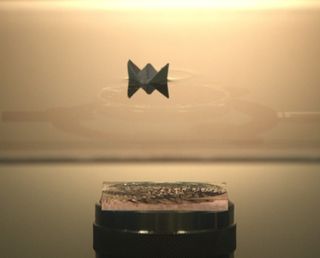
3D-Printed Acoustic Holograms Could Move Objects in Midair

3D-printed plastic blocks can now be turned into acoustic holograms that generate 3D shapes made of sound, which could function like sonic "tractor beams," according to a new study. This could lead to innovative ways to manipulate objects in midair without touching them, the researchers said.
This finding could also help scientists develop ultrasound therapies with sound fields sculpted to destroy unhealthy tissues in the body while leaving neighboring healthy cells intact, the researchers added.
Conventional holograms are a special kind of 2D photograph that, when lit up, essentially turn into windows onto 3D scenes. The pixels making up each hologram scatter light falling onto them in very specific ways, causing these light waves to interact with each other to generate an image with the illusion of depth. [10 Futuristic Technologies 'Star Trek' Fans Would Love to See]
The new acoustic holograms are plastic blocks with complex structures that scientists created using 3D printers. These printers form 3D structures by placing layers of material onto surfaces, much like how regular printers deposit layers of ink. When an acoustic hologram the researchers developed is placed in front of an audio speaker or a transducer, the 15,000 pixels within it can scatter sound waves to generate complex 3D fields of sound.
Sound waves apply pressure on matter, and previous research found that "acoustic tweezers" and "acoustic tractor beams" could generate complex 3D sound fields in air or liquids to push, pull and spin objects such as small animals. However, these devices usually require elaborate arrays of multiple transducers, whereas this new acoustic hologram requires only one ultrasonic transducer to generate a complex 3D acoustic field.
"Instead of using a rather complex and cumbersome set of transducers, we use a piece of plastic that cost a few dollars from a 3D printer," said study senior author Peer Fischer, a physical chemist at the Max Planck Institute for Intelligent Systems in Stuttgart, Germany.
In addition, the acoustic hologram could generate 3D sound fields about 100 times more detailed than ones produced by other techniques, the researchers said. For instance, they could use an acoustic hologram to assemble microparticles of silicone rubber suspended in water into a "dove of peace," as well as suspend drops of water in midair.
Sign up for the Live Science daily newsletter now
Get the world’s most fascinating discoveries delivered straight to your inbox.
"With an incredibly simple approach, we can create extremely complex, sophisticated acoustic fields that would be difficult to achieve otherwise," Fischer told Live Science.
Acoustic holograms could help doctors sculpt powerful ultrasonic fields to get rid of unhealthy tissue while avoiding healthy areas, Fischer said. Acoustic holograms could also help improve the resolution of ultrasonic imaging, he added.
The scientists are now exploring ways to use acoustic holograms to generate sophisticated 3D sound fields that are not static, but animated.
The scientists detailed their findings online today (Sept. 21) in the journal Nature.
Original article on Live Science.
